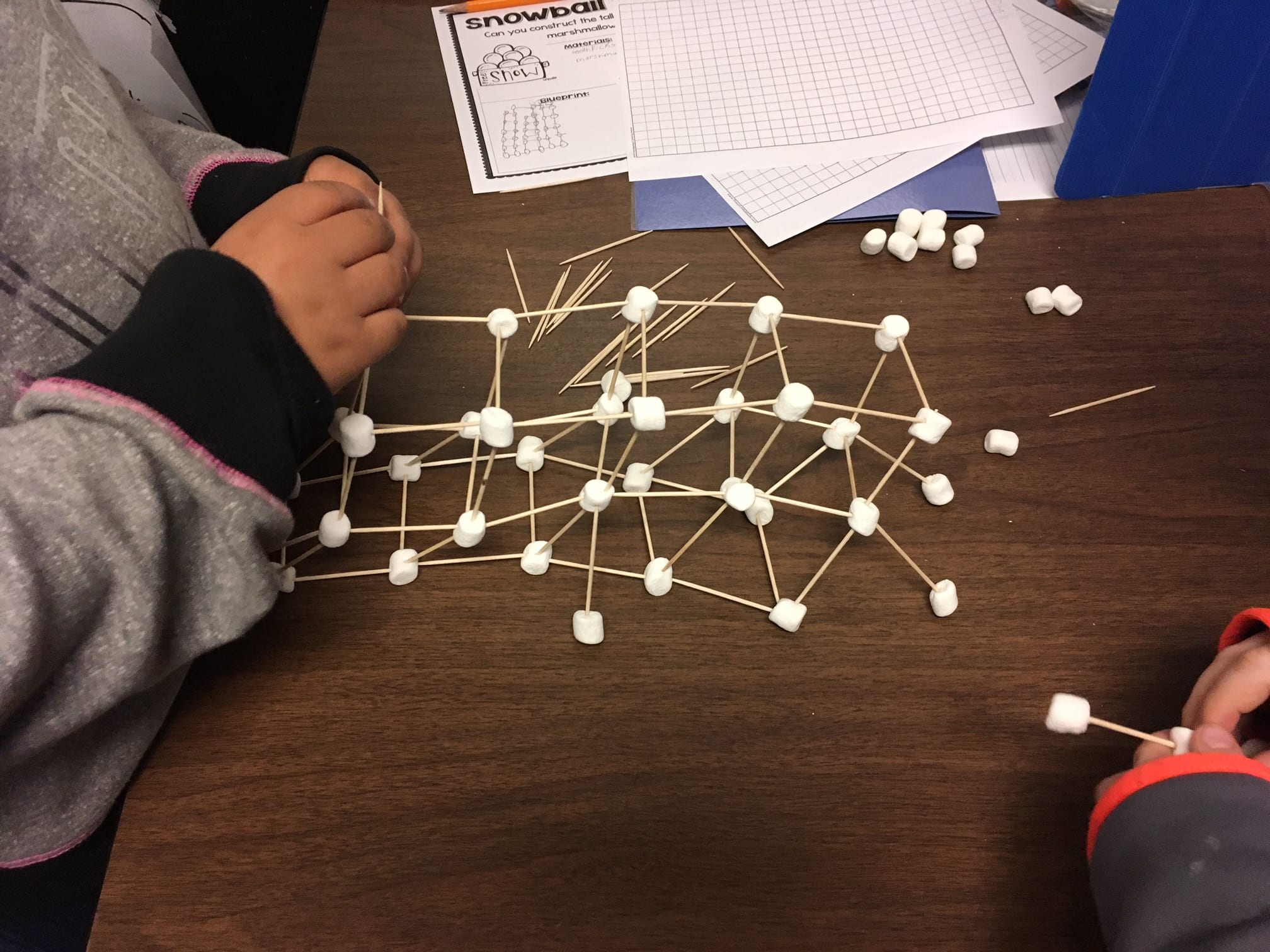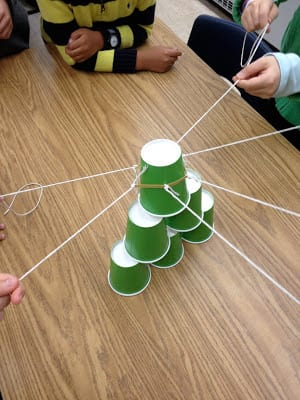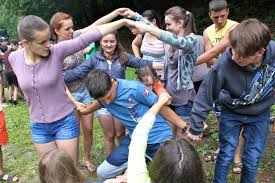Watch the video below to see three of our favorite team-building games in action, then read on for more ideas.
1. The Perfect Square
This activity requires strong verbal communication and cooperation. All you need is a long rope with the ends tied together and something to serve as blindfolds for students, such as bandanas or fabric strips. Have students stand in a circle holding the rope in front of them. Signal them to put their blindfolds on and set the rope on the ground in front of them. Ask students to turn and walk a short distance away from the circle. Assign students who may need help a partner to work with. Finally, have everyone come back to the rope and try to form a perfect square with their blindfolds on. Set a time limit to make it more challenging.
2. Electric Fence
Tie a string between two stacks of chairs to create an “electric fence wire” that comes to about the average waist height on your students. Have students gather on one side of the fence and form a human chain by holding hands. The objective of the game is to get the entire team from one side of the wire to the other without touching the wire. Rules: students can only go over (not under) the wire and must be holding hands at all times. They will have to cooperate to help each other over one at a time without touching the wire. If you have students who are not physically able to participate, they can act as judges making sure no one drops hands or touches the wire.
3. All My Friends
This game is a quick way to take note of your students’ interests. Start by having your students form a circle. Stand in the middle and say, “All my friends like … ,” filling in the blank with anything you enjoy—hiking, sushi, reading—anything! Any student who also enjoys the thing you mentioned has to switch spots with another person in the circle. Much like musical chairs, whoever doesn’t have a spot goes in the middle and says, “All my friends … ,” starting the process all over again.
4. Birthday Line Up
This is a fun activity to get kids lined up. It may take 5-10 minutes depending on the age of your students, so plan accordingly. The objective is to have students line up in order of their birthdays—January 1st through December 31st. To do this, they will need to know the order in which the months fall as well as their own birthday. They will also need to talk with one another in order to figure out who goes in front of whom. To make it super challenging, tell them they must do it without speaking at all, only using hand signals.
5. Four-Way Tug of War
This fun outdoor activity is double the fun of traditional tug of war. Tie two long jump ropes together at their center points, creating an X shape. Tie a bandana around the center point. Next, use cones to form a circle that fits around the X. Form 4 equal teams and have each team stand at one of the four ends of the ropes. At your signal each team will begin pulling. The objective is to be the first team to pull the others in their direction far enough for the bandana to cross to the outside of the circle of cones. Students who feel nervous about participating can serve as referees, making sure every one is safe.
6. Rock, Paper, Scissors Tag
You’ll need some running around space for this activity. Divide students into two teams. Before you begin, stake out the boundaries and position a home base at either end for each team. For each round each team must confer and decide whether they will be rock, paper or scissors. Have the two teams line up facing one another and on your signal have all players flash rock, paper, scissor, shoot! The kids on the losing team must run back to their base before they are tagged by one of the kids on the winning team.
7. Flip It Over Challenge
This activity takes a little creative thinking. Divide students into two teams. One team will do the challenge first while the other team watches, then they will switch places. Have all members of the team stand on a flat bedsheet, tarp or blanket (kids should fill up all but about a quarter of the space). Challenge the team to flip over the sheet/tarp so that they are standing on the other side of the sheet/tarp without stepping off or touching the ground.
8. Get to Know You Balloons
This is a fun twist on traditional icebreaker activities. Give each student a balloon (not blown up) and a slip of paper. Ask them to write a “get to know you” question on their paper such as How many brothers and sisters do you have? Do you have any pets? What’s one fun thing you did this summer? Next, have them put their question inside the balloon, blow it up, and tie the end.
When everyone is ready, have them gather on the rug and on your signal, toss their balloon up in the air. Give them a couple of minutes to bat the balloons around then call stop. Have each student grab one balloon and come sit in a circle.
Go around the circle and, one at a time, have students pop their balloon, read the question inside and answer the question.
9. Art Reproduction Puzzle
Divide students into groups of six or eight (or larger if you want to make the task more difficult). Provide each team with an image and blank pieces of white card stock, one per team member. First, each team must cut up the image into the same number of pieces as there are group members. Then, each player will take one of the pieces of the image and reproduce it onto their blank piece of card stock with pencils, colored pencils, or markers. (If the team cuts the image into irregularly shaped pieces, each team member must then cut their blank paper into the same shape.) When every team has created the pieces of their puzzle, they will switch pieces with another team. The team will work together to solve the puzzle.
10. Hot Seat
This fun game is a lot like the game show Password. Split your class into two teams and have them sit together in teams facing the white board or chalk board. Then take an empty chair—one for each team—and put it at the front of the class, facing the team members. These chairs are the “hot seats.” Choose one volunteer from each team to come up and sit in the “hot seat,” facing their teammates with their back to the board.
Prepare a list of vocabulary words to use for the game. Choose one and write it clearly on the board. Each team will take turns trying to get their teammate in the hot seat to guess the word, using synonyms, antonyms, definitions, etc. Make sure team members work together so that each member has a chance to provide clues.
The student in the hot seat listens to their teammates and tries to guess the word. The first hot seat student to say the word wins a point for their team. Once the word is successfully guessed, a new student from each team sits in the hot seat, and a new round begins with a different word.
11. Hula-Hoop Pass
This activity helps kids work on listening, coordinating, and strategizing skills. It works best with smaller students. Have your students stand in a big circle. Place a Hula-Hoop on one student’s arm and have them join hands with the student next to them. Ask all the other students to join hands to close up the circle. The objective of the game is to pass the Hula-Hoop all the way around the circle without unclasping hands. Students will have to figure out how to maneuver their bodies all the way through the hoop to pass it on.
12. Eye Contact
This is a great activity to support nonverbal communication skills. Choose 10 students to participate in the first round. The others can gather around the edges and watch. Designate a player one. To begin, player one makes eye contact (no words or hand motions) with another player (player two) and gives them a signal that means go. When player two says go, player one starts moving slowly toward them to take their place in the circle. Player two then makes eye contact with another player (player three) and gives them a signal meaning go and starts moving toward them. The objective of the game is to time each player’s command so that each player makes space for the others in time. After the first round, switch out the teams until everyone has had a chance to play.
13. Marshmallow-and-Toothpick Challenge

Divide students into groups of equal numbers. Pass out an equal number of marshmallows and wooden toothpicks to each group. Challenge the groups to create the tallest, largest, or most creative structure in a set amount of time, each member taking turns doing the actual building. Afterward, have each group describe what they made.
14. Hey, Me Too!
This game shows kids how much they have in common with one another and is a variation of the game above. Before the game begins, have students make “auction paddles” with these super cute emoji plates (or have students create their own out of plain paper plates) and a large Popsicle stick. Everyone sits at their desk or table. The teacher calls out a trait, such as curly hair or freckles, and everyone with that trait raises their paddle. Give students a few seconds to look around and take note. Play continues as above.
15. Common Ground
This activity helps students discover fellow like minds in their class. Make these four labels and put each in a different corner of the room: Strongly Agree, Agree, Disagree, Strongly Disagree. Students start in the middle of the room or in their seats. The teacher reads a statement, and students move to the corner of the room that represents their opinion on statements, such as “students should get longer recess,” or “cats are better than dogs.” An alternative way to play this game for students who may have difficulty moving around the room is to have students remain seated and raise a piece of colored construction paper to show their response. For instance, red = strongly disagree, orange = disagree, blue = agree, and purple = strongly agree.
16. Detective
This game requires teamwork and close observation. Students stand in a circle. One student (the detective) steps outside. While out of the room, another student is chosen as the leader to start the motion. The leader begins a motion, for instance, tapping the top of their head, while the rest of the students in the circle follow along. The student in the hallway returns to the room and goes to the center of the circle. After a couple of minutes, the selected student changes the motion, for instance clapping their hands, and the rest of the students follow along. The detective has to figure out which student is the leader. The detective gets three guesses. Then a new leader and detective are chosen for the next round.
17. Storytelling Round-Robin
This activity helps students pool their creative resources. Students can sit in a circle or at their desks. The teacher will begin with the first line of the story, for instance, “Once upon a time there were three children walking through the forest … .” One by one, each student adds one sentence with new details to the story. The story cannot end until every student has participated.
18. Fingertip Hula-Hoop

In this game, children stand in a circle and raise their arms then extend their index fingers. The group supervisor places a Hula-Hoop so that it rests on the tips of the children’s fingers. Children are told that they must maintain a fingertip on the hula hoop at all times, but are not allowed to hook their finger around it or otherwise hold the hoop; the hoop must simply rest on the tips of their fingers. The challenge is for the children to lower the hoop to the ground without dropping it. To make this more challenging, you can place communication constraints on the children—no talking or limited talking, for example. See this YouTube video for a demonstration.
19. Mingle, Mingle Groups
This activity is good for encouraging kids to mix it up. Students mill about the room saying, in a quiet voice, “Mingle, mingle, mingle.” Then, the teacher calls out a group size, for example, groups of three. Students must break into groups of that size. The goal is to form different groups of individuals every time. If a person tries to join a group with whom they have already partnered, they must find a different group. After a few rounds, the process may take a bit of rearranging.
20. Bumpity-Ump-Bump-Bump
This is a fun name game that requires quick thinking! Students stand in a large circle. One student comes to the middle. That student walks around the inside of the circle, stops in front of one person, and gives them a direction. There are four choices: Left = say the name of the person to the left; right = say the name of the person on the right; it = say the name of the person who is it; or self = say one’s own name. After the student gives the direction, they say “bumpity-ump-bump-bump!” out loud. The student who was given the direction races to say the name of the correct person before the student finishes the phrase. If they can’t, they’re the next person on the inside of the circle.
21. Group Hop
This activity requires coordination and communication. Divide students into groups of between four and six people. Have the students in each group stand in a straight line with their right hand on the shoulder of the person in front of them and their left leg forward so that the person in front of them can hold their ankle. The group then sees how far they can hop along together without toppling over. Once groups get the hang of hopping, you can hold a competition to see who can hop the farthest or longest.
22. Sneak Peek
This problem-solving activity will help students learn to communicate effectively. Before the game begins, the teacher builds a small sculpture with LEGOs or building blocks and keeps it covered in an area that is of equal distance from all the groups. Students are divided into teams of four or five, and each team is given enough blocks to duplicate the structure.
To begin the game, the structure is revealed, and one member from each team is allowed to come up to look at it closely for 10 seconds, trying to memorize it before returning to their team. Once they return to their team, they have 25 seconds to instruct the group on how to build a replica of the structure. After one minute of trying to recreate it, another member from each team can come up for a sneak peek before returning to their team and trying again. The game continues until one of the teams successfully recreates the original structure.
23. No-Hands Cup-Stacking Challenge

This hands-on group challenge is an exercise in patience and perseverance, not to mention a total blast! Decide how many students you want in each group and tie that number strings to a single rubber band, making one for each group. Each person in the group holds onto one of the strings attached to the rubber band, and as a group, they use this device to pick up the cups (by expanding and contracting the rubber band) and place them on top of each other in order to build a pyramid. See detailed instructions here.
24. Tick Tock
This activity helps students negotiate and work together toward a common goal. Make a list of tasks on chart paper, assigning a point value for each job. For example: Do 25 jumping jacks (5 points); make up a nickname for each member of the class (5 points); get every person in the class to sign a piece of paper (15 points); form a conga line and conga from one end of the room to the other (5 points, 10 bonus points if anyone joins you); etc. Make sure you list enough tasks to take up more than 10 minutes. Divide your students into groups of five or six and give them 10 minutes to collect as many points as they can by deciding which tasks from the list to perform.
25. Body Parts
Students mingle around the classroom until the teacher calls out a body part and a number, for instance “four knees!” Students have to form a group of four students closest to them (finding new partners each time) and join together one knee each or a group of two with both knees together. Anyone who isn’t part of a group gets to call the next round.
26. Human Alphabet
You need a large open space for this game. Have students spread out and guide them through a few rounds of forming letters with their bodies. For instance, “Use your body to make a ‘T’ … now make an ‘O!’”
Next, call out a simple short word, such as “so” or “dog.” Students will have to team up to form the word, with each student using their body to form one of the letters. Start with two-letter words, then three, then four. If students want a challenge, come up with a phrase that will take the whole class to complete.
27. Applause, Please.
Form groups of between three and five students. One person from each group (the finder) steps out of the classroom. The rest of the group picks an object (for instance, the pencil sharpener) in the classroom for the finder to find. When the finder comes back in, they begin walking around the classroom in search of the object. The others cannot say anything, but they can give hints by using applause to lead the finder in the right direction. If the finder is far away from the object, the group will clap slowly and softly. When the finder gets close, the group will applaud faster and more loudly until the finder picks the correct object.
28. Caterpillar
You’ll need Hula-Hoops for this fun activity. Divide students into groups of four. Lay out four Hula-Hoops per group and have one student stand in the center of each one to form teams of “caterpillars.” Line all of the teams up at the end of a field or large open space. Set out four or five objects in front of the lines, such as cones, foam blocks, or balls.
The goal of the game is to collect as many objects as possible by moving the caterpillar forward. To move forward, the last player in line steps into the hoop with the player in front of them, picks up their empty hoop, and passes it overhead to the front of the line.The front player then places the hoop on the ground in front of them and steps into it. Every player then shifts forward, moving the caterpillar. Only the front player may pick up objects, but it is the team’s job to carry the collected objects throughout the game. The game ends when there are no more objects on the ground. Find more detailed instructions here.
29. Golf Ball Trampoline
Divide the class into teams of six or eight. Provide each team with a large bedsheet or tarp that has several slits cut into it and have students hold onto the edges and spread the sheet out so that it is tight. Place a golf ball in the center of the sheet. Students must work together to maneuver the ball around the sheet without having it fall through one of the slits. When a team’s ball falls through, they are out and must sit until there is only one team left. Mix up teams and start over again.
30. All Aboard
For this activity you will need a few jump ropes. Divide students into groups of six or eight. Have each group make a circle with their jump rope (their “lifeboat”) on the ground so that the ends are touching. Now have all the members of each group get into their lifeboat. This should be easy the first time. Then have all players get out and reduce the size of their circle by one foot. Again, all players need to get into the boat. Repeat this process, making the lifeboat smaller and smaller while you watch your students come up with creative solutions for making sure that everyone fits safely inside their boat.
31. Pretzel, Unpretzel

Divide your class in half and have each group choose one pretzel maker and two unpretzelers. Direct the unpretzelers to turn their backs. Have the rest of the students in each group form a circle and hold hands. Now, have the pretzel maker direct the students (with words only) to twist around, step over, and duck under each other’s arms to form a human pretzel. Once they are sufficiently twisted, call the unpretzelers over and have them try to direct the students (with words only) in order to detangle them. Students cannot drop their hands at any time. The first team that successfully unpretzels their group wins.
32. Creative Solutions
This activity encourages creative problem solving. Pick four or more different objects, such as a coffee can, a potato peeler, a knit hat, and a book. Split students into even teams. Now present a situation where each team has to solve a problem using only those objects. These scenarios can be anything from students are stranded on a desert island and must find a way to get off or survive to students must save the world from Godzilla. Give the teams five minutes to figure out an original solution to the scenario, including ranking each object based on its usefulness. When the five minutes are up, have each team present their solution along with their reasoning to the class. (Tip: Don’t make the scenarios so easy that it is obvious which objects will be most useful.)
33. Zip, Zap, Zop
This game is all about focus and energy. As students pass the energy across the circle (in the form of a Zip, a Zap, or a Zop), they make eye contact with the person they send the energy to and work together to keep the rhythm going. To pass the energy, have students put their hands together in a teepee in front of their chest. Player one moves their hands away from their chest, makes eye contact with and points at a classmate, and says “Zip.” Then that student repeats the process with another student and says “Zop.” That player repeats with a “Zop,” then it starts all over with “Zip.” Make sure students are making eye contact when they pass the energy. To make sure everyone is picked, students can put their hands down at their sides after their turn.



No comments:
Post a Comment